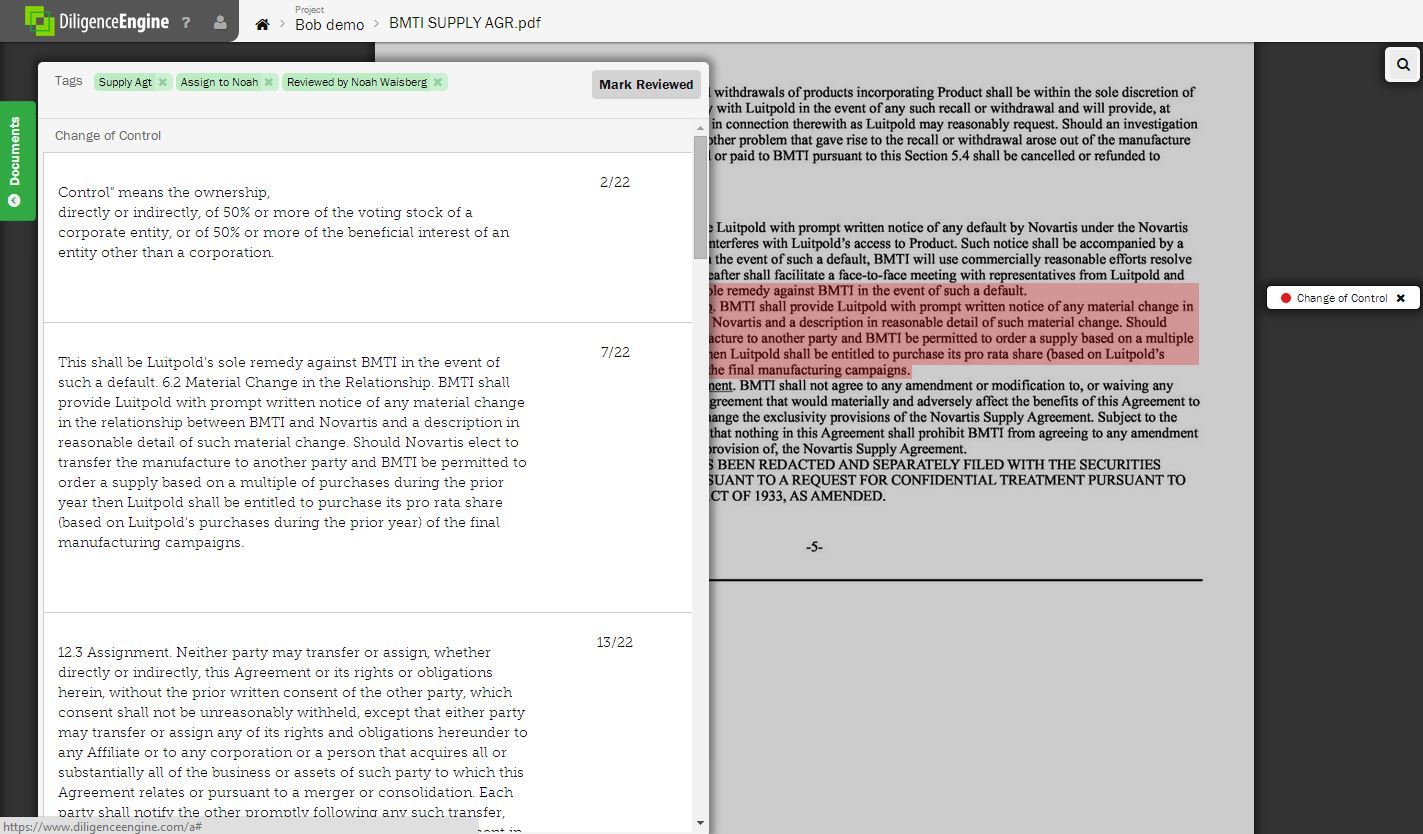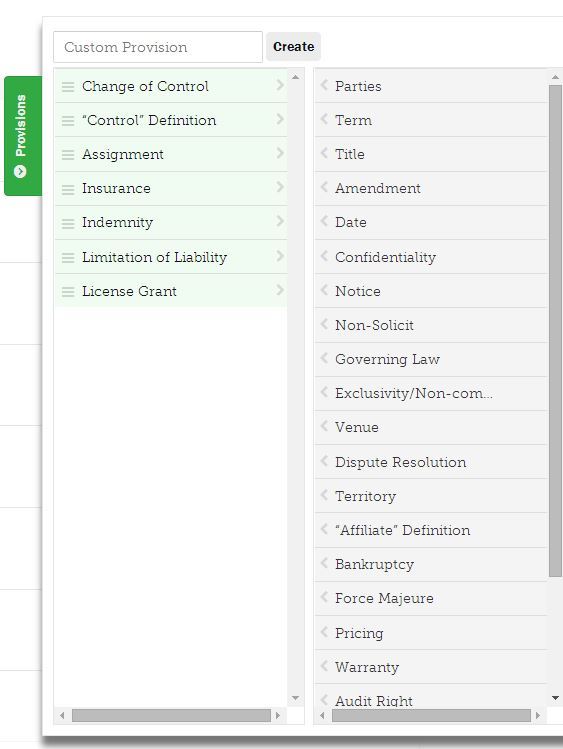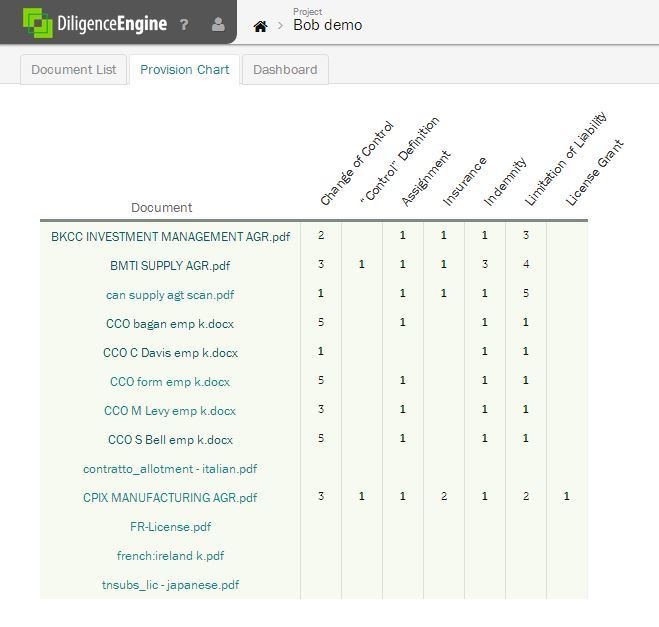
Results are shown in split screen, with the summary on the left and the source document on the right.
Can technology streamline M&A due diligence reviews in the same way it did e-discovery reviews? Can it improve on the time-consuming and error-prone process of manually reviewing mounds of contracts in advance of a corporate acquisition?
Noah Waisberg believes it can. The former Weil, Gotshal & Manges corporate associate teamed up with computer scientist Alexander Hudek to found DiligenceEngine, a platform that uses computer technology to enhance the speed and accuracy of contract review in mergers and acquisitions.
[Subsequent to publication of this post, the company changed its name to Kira Systems.]
An M&A may require review of dozens, hundreds or even thousands of contracts — plodding work that typically falls to junior associates in large corporate firms. Lawyer hunt for key clauses that may affect the value of the deal or of the property being transferred. They look for language regarding change of control, indemnity, insurance, governing law and the like. This is eyes-on, document-by-document review that is time consuming, expensive and prey to human error.
“You get junior lawyers to go and find all this,” Waisberg explained in a recent phone call. “Turns out, they’re slow. This is complex work. It takes a minute to five minutes a page. Junior lawyers tend to make mistakes. They’re tired from working late nights. Or they don’t know what a change-of-control provision looks like and it isn’t always labeled ‘change of control.'”
DiligenceEngine is trained to search for the provisions an M&A lawyer would want to see. Load your documents, select the types of provisions you are interested in, and it finds them. It extracts the relevant text into a summary chart that you can view on your computer as you compare it against the original document or export to Word or Excel to send to a senior lawyer.
Less Time, Greater Accuracy
Waisberg and Hudek began to develop DiligenceEngine in 2011 and planned to take it to market in four to six months. Achieving the accuracy they needed proved harder than they had anticipated, however. They finally rolled out an alpha version early in 2012 and continued to refine the platform’s accuracy to where they felt it was fully ready to take to market near the end of last year.
 Waisberg conducted his own admittedly small-scale testing of speed and accuracy by pitting himself against a former colleague with similar M&A experience. In the first round, they both did eyes-on, page-by-page review, with Waisberg using DiligenceEngine and the colleague not. Waisberg’s review took 20-30 percent less time. In the next round, Waisberg only spot-checked DiligenceEngine’s results, much as a senior associate might spot-check a junior associate’s work. By just spot-checking, his review took 60 percent less time.
Waisberg conducted his own admittedly small-scale testing of speed and accuracy by pitting himself against a former colleague with similar M&A experience. In the first round, they both did eyes-on, page-by-page review, with Waisberg using DiligenceEngine and the colleague not. Waisberg’s review took 20-30 percent less time. In the next round, Waisberg only spot-checked DiligenceEngine’s results, much as a senior associate might spot-check a junior associate’s work. By just spot-checking, his review took 60 percent less time.
More importantly, in both rounds, the review using DiligenceEngine was more accurate than the review without it. As one example, the other reviewer found seven change-of-control clauses, whereas Waisberg found those seven plus five more. One of the provisions missed by the other reviewer contained a significant termination upon change of control.
Note what I said about the first round. Both reviewers looked at every page of every contract, but one did it significantly more quickly. There are a couple of reasons for this. For one, DiligenceEngine automatically copies and pastes the relevant contract provisions into the summary sheet. Just avoiding that process of copying and pasting and organizing the summary sheet is a time saver. On top of that, because DiligenceEngine has already extracted the relevant provisions and highlighted them in the document, the reviewer is able to scan the pages more quickly.
How it Works
Let me walk through how you use it.
You start by creating a new matter and, if you wish, inviting others in your organization to work on the matter. You can choose to give others full editing access or limit them to read only.
Next you upload your documents. You can use the “upload” button for this or simply drag and drop files and folders from your desktop on to DiligenceEngine. The platform accepts more than 60 document formats, including Word, PDF and scans with or without OCR. If an image file is loaded, DiligenceEngine will convert it to text using the integrated OmniPage OCR. Because of that, all text in all documents is fully searchable.
The platform also detects more than 40 languages in uploaded documents and automatically adds tags to documents indicating when they are in a language other than English.
Once your documents are loaded, DiligenceEngine displays them in a document list. A slide-out panel lets you select the provisions you want to search for in your documents. The 30 selections include change of control, assignment, insurance, limitation of liability, force majeure, warranty and the like. You can also add custom provisions.
Once you’ve selected the provisions, simply click on a document title to see the summary. DiligenceEngine shows a split screen, with the summary on the left and the source document on the right. As you read through the sections of the summary, a “go to page” link takes you to the corresponding place in the document. The document is highlighted to show the corresponding provision.
You can use this side-by-side view to review the entire document or to spot check the platform’s selections. As you complete a document, you can click “Mark Reviewed” to finish it or you can tag it for further review or follow-up. A slider menu on the left side of the screen lets you jump to another document without returning to the main document list.
The summary can also be downloaded, either for all your documents or for only those you select. You can download the summary in Word or Excel.
DiligenceEngine also has a feature for comparing and blacklining documents in bulk. This lets you select a number of documents to compare, designate one as the “base” for comparison, and then get a summary that shows a meta blackline with the combined results for all compared documents. From these combined results, you can hover over highlights to see details and then click directly into the source document.
Each project page also displays a provision chart and a dashboard. The provision chart shows how often it found each provision and in which document. The dashboard gives a visual summary of search results and review progress.
What Does it Cost?
DiligenceEngine can be accessed via the cloud or installed locally behind a firewall. The cost of the cloud version is roughly $10 per contract, with allowances for volume of documents or frequency of use. (There is no charge under 25 documents.) Thus, for 200 contracts, the cost would be $2,000; for 1,000 contracts, it would be $7,500. There are no per-user charges.
The company will also consider licensing the use of the platform.
For companies and law firms that want the locally-installed version, the company will also charge for installation and set up.
For enhanced security, DiligenceEngine offers two-step verification at log-in. Users can turn this on or off.
The Bottom Line
Waisberg says that his customers so far include a number of AmLaw 50 firms as well as a number of Canada’s leading firms. He also markets it directly to corporate legal departments.
You might think lawyers would scoff at a product that results in them billing fewer hours. But Waisberg says that a big part of DiligenceEngine’s value to lawyers is as a check and balance on accuracy. Every firm wants to be perfect in its due diligence review, but the likelihood, given human error, is that few ever are. If DiligenceEngine did nothing else than provide a sort-of auditing function, it would be worth using.
For corporate legal departments, DiligenceEngine’s appeal is in its savings. If Waisberg’s estimates hold true that it can reduce review time by 20-60 percent, those chopped hours can translate to major savings in a large deal.
“We provide more accurate results in less time,” Waisberg told me. From what I have seen, DiligenceEngine appears able to deliver on that promise.
 Robert Ambrogi Blog
Robert Ambrogi Blog
